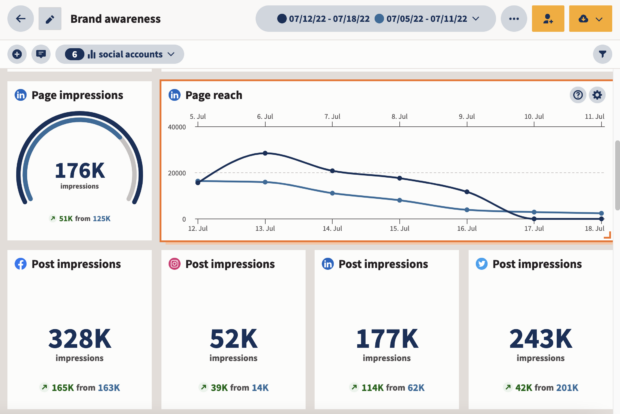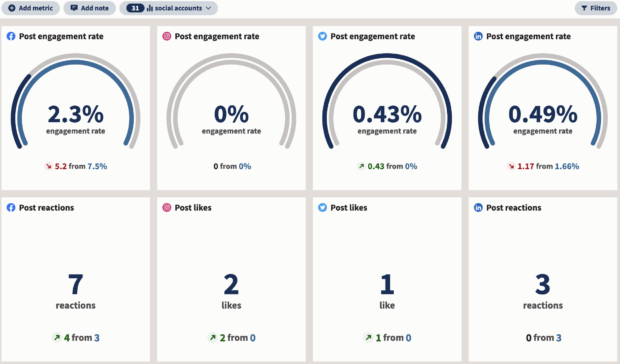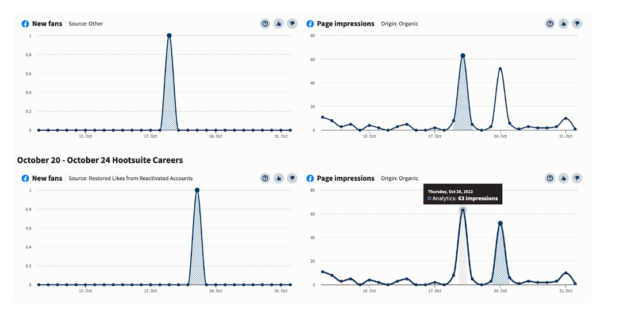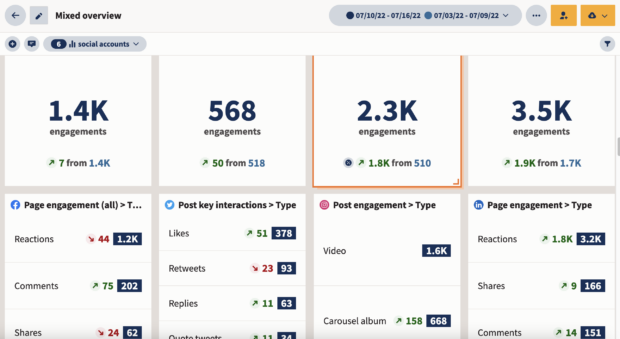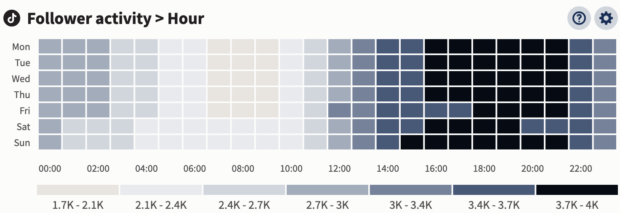Social Media Analytics in Healthcare: Complete Guide
Let’s just get this out of the way off the top: people who work in healthcare are heroes. And sometimes even heroes need the right tools to do their best work.
Social media analytics is one of the most powerful tools a healthcare organization can use to improve external communications. Used right, social media analytics in healthcare can help administrators save time, identify patient trends, fight misinformation, and protect an organization’s reputation.
Understanding social media metrics from a healthcare perspective is also key to creating an effective social media strategy for your organization. In this post, we’re honored to share everything healthcare providers need to know to do social media analytics right.
Bonus: Download a free bundle of social media tools designed specifically for the healthcare industry — including post ideas, a calendar template, a social policy template, and a social media strategy template.
What is social media analytics in healthcare?
Social media analytics in healthcare refers to the practice of collecting, analyzing, and interpreting data from social media platforms. These metrics can help healthcare organizations gain valuable insights and make informed decisions.
With 4.74 billion people now active on social media, healthcare organizations across the world are embracing the opportunity to leverage these platforms to promote health initiatives, connect with patients, and draw attention to important causes and issues.
By using social media analytics to understand the trends, sentiments, and behaviors of both patients and the general public, healthcare professionals are better able to effectively tailor their strategies and improve patient care.
Seems like some pretty good reasons to start looking at some numbers, no? Here’s an example of a social media analytics Brand awareness report in the Hootsuite dashboard.
Benefits of social media analytics in healthcare
Save time by doing more of what works—and less of what doesn’t
Social media analytics allows healthcare organizations to track the performance of their social media campaigns and identify what content resonates with their target audience.
By analyzing engagement metrics such as likes, shares, and comments, healthcare professionals can determine which posts are most effective in driving patient engagement.
The World Health Organization, for example, can see videos of people dancing (part of a “get active” campaign) get tens of thousands of views, while videos related to a meditation initiative are less popular.
@who Can #Japan
go for a second win at the @FIFA World Cup? SAMURAI BLUE it’s time to #BringTheMoves !
This is valuable data that helps save time and resources, letting organizations focus on creating and promoting content that generates the highest impact. Above is an example of an Engagement report in the Hootsuite dashboard, where you can see what kinds of posts are more popular than others.
Identify trending patient topics
Through social media analytics, healthcare organizations can monitor and identify the most popular and relevant topics discussed by patients. What’s hot? What’s not? Your social media analytics will tell you.
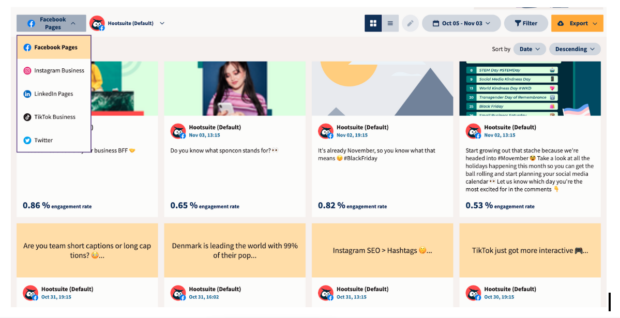
When healthcare professionals have the chance to understand the concerns, interests, and questions of their target audience, they can proactively address these topics through informative content, educational campaigns, and even direct engagement with patients.
This sort of responsive content not only fosters patient trust and loyalty but also ensures that healthcare organizations stay current and responsive to patient needs. In other words: when you listen, they listen.
Understand your ROI
Investing in social media campaigns requires careful evaluation of their effectiveness. If a Facebook ad goes out into the world and gets 500 clicks but you didn’t notice, did it even really happen?
With social media analytics, you can find insights into key metrics such as reach, impressions, click-through rates, and conversions, which will allow you to accurately assess your organization’s return on investment (ROI).
Information, as you well know, is power. Understand the impact of your campaigns so that you can refine your strategies, optimize your resources, and allocate budgets more effectively.
For instance, the Cleveland Clinic scored a big hit with this “How to exercise with asthma” video. The data they glean from this TikTok post (when it was posted, how many views it got, who the audience was) will be incredibly helpful if they try to replicate the success.
@clevelandclinic 3 tips to #exercising with #asthma
#fyp #asthmacheck #asthmaawareness #exercisetips #asthmatiktok #healthtips
Stay ahead of competitors
Staying ahead of your healthcare competition (or industry peers) is crucial. And to do that, social media analytics is key.
Social media analytics enables healthcare organizations to monitor and benchmark their performance against industry peers and competitors.
Health Canada, for instance, might want to see how its posts stack up against peer organizations in the U.S. or Europe. What kind of engagement and following do those accounts enjoy?
[1/2] Did you recently travel to Matamoros, Mexico for a cosmetic or elective medical procedure which included epidural anesthesia? You may have been exposed to fungal meningitis, a serious but non-contagious, infection.https://t.co/PSMG43eeCo pic.twitter.com/nVxQbcOsBi
— Health Canada and PHAC (@GovCanHealth) June 9, 2023
By analyzing engagement metrics, content strategies, and the audience demographics of competitors, healthcare organizations can uncover new opportunities for improvement (or learn what doesn’t work).
Create and publish posts. Talk to patients and prospects. Measure ROI. Save time and grow faster.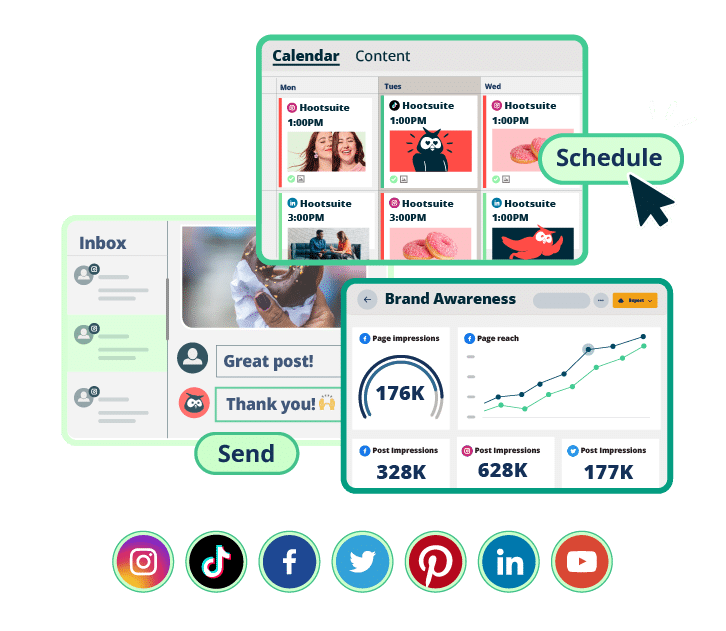
Stay ahead of misinformation
We all know that misinformation can spread like wildfire on social media. And misinformation about health and wellness can cause serious harm.
Social media analytics can help preserve factual accuracy in real time. Analytics tools can help healthcare organizations monitor social media platforms for inaccurate information, rumors, or false claims related to healthcare—in turn, organizations can respond promptly with accurate information, fact-checking, and educational content.
Why you see health misinformation on social media… https://t.co/JcM10Oq5DY pic.twitter.com/Q1sZSu8yao
— U.S. FDA (@US_FDA) June 5, 2023
Not only does this sort of activity protect the public from potential harm, but it also helps build trust and credibility with patients. Everybody wins!
Protect your reputation
Social media analytics plays a vital role in reputation management for healthcare organizations — and in a field where trust and reliability are incredibly important, that’s no small feat.
By actively monitoring social media platforms, organizations can identify and respond to any negative sentiment or feedback from patients.
Social listening also allows organizations to promptly address concerns, provide support, and resolve issues — basically, it’s one more way to provide top-notch customer service.
Social media analytics also helps organizations identify positive sentiments and testimonials. Collect these sweet notes and share ‘em with the world to build a positive brand image and enhance patient satisfaction.
Top tips for using social media analytics in healthcare
Using social media analytics in healthcare ultimately isn’t that different from using social media analytics in other industries. But if you want to make the most of your analytics tools for your healthcare organization, here is our best advice.
Define your goals and objectives clearly
Metrics aren’t super helpful if you don’t actually have anything specific you’re trying to measure. Start your social media analytics journey by clearly defining your goals and objectives. What insights do you want to gain? What information will help you with your organization’s overall strategy?
Your objective might be to improve your reach in order to spread the word about your organization’s services to a broader audience. Or maybe your dream is to create a social account that experiences really high engagement as part of your overall goal to improve your reputation with the community.
Not sure where to start? Check out our guide to setting (and exceeding!) social media goals here.
Use the right social media analytics tools
There are a ton of social media analytics tools available out there to help you track, analyze, and visualize data effectively. (We even put together a list of the best-of-the-best social analytics tools here.)
Our favorite, of course, is Hootsuite. It’s got a robust analytics feature but also can help teams with scheduling, customer service, and social listening.
Track key metrics (that are meaningful to you!)
This goes hand-in-hand with defining your social media goals: identify the key performance indicators (KPIs) that align with your objectives and track them consistently.
Metrics such as engagement rate, reach, impressions, and conversions can provide valuable insights into your social media performance — this list of 16 key metrics to watch outlines all your options.
Hot tip: You can schedule automatic Insights reports for your key metrics with Hootsuite Analytics
How to Create a Social Media Report: 2023 Edition [Free Template]
Analyze your data regularly
Analytics don’t mean much out of context. It’s important for healthcare organizations to plan recurring reviews of social media metrics in order to assess what’s working and what’s not.
Schedule regular analysis of your social media data to uncover trends, patterns, and opportunities. This will help your team discover insights that can inform your content strategy, campaign optimization, and overall decision-making.
Engage with your audience
Wanna boost those metrics so your next social media Insights report really pops? Then get ready to actively engage with your audience on social media platforms.
Respond to comments, address concerns, and provide accurate information. This sort of activity will not only build trust but also contribute to your overall social media performance — and you’ll absolutely see your hard work reflected in the numbers.
Collaborate with other departments
Don’t hog those numbers to yourself! Social media analytics can provide valuable insights not only for your healthcare organization’s marketing team but also for other departments such as customer service, research, and development.
Collaborate with these departments to leverage the full potential of social media analytics across your organization. That might mean brainstorming about how to improve a particular metric or outsourcing content creation or getting input on what other departments’ social media goals may be.
The #1 social media analytics tool for healthcare professionals
Why do we think Hootsuite’s analytics products are the best choice for healthcare pros? Because they can do everything we’ve mentioned above and much, much more.
Hootsuite Analytics help healthcare social media managers with sophisticated (and, TBH, visually pleasing) reporting and measurement for all of their different social media accounts.
But Hootsuite’s other social media management tools are also incredibly helpful for healthcare organizations. Practice social listening with Hootsuite Streams, keep on top of communications with Hootsuite’s Inbox feature, and plan and executive organic and paid cross-platform social media campaigns, all in one convenient dashboard.
But back to Hootsuite Analytics specifically.
Hootsuite Analytics is a social media analytics tool that lets you easily track the performance of all your social channels in one place so you can replicate what works and get more engagement.
The tool also makes it easy to create custom reports to showcase your results to your boss and share insights with your team.
Hootsuite Analytics collects your stats from Facebook, Instagram, Twitter, LinkedIn, and TikTok.
It helps you track metrics like:
- Reach
- Engagement rate
- Impressions
- Likes
- Plays
- Shares
- Clicks
- Saves
- Comments
- Video views
- New followers
- Total followers
- Profile visits
- Reactions
- Negative feedback rate
- Website clicks
- Average time watched
- Number of messages, calls, and emails
- Daily engaged users
- Website clicks
- And much more
You can set up custom boards that give you an overview of your most important metrics at a glance over a select period of time.
… and look up much more granular information, down to the performance of every individual post you published.
With Hootsuite Analytics, you can also:
- Find out when your audience is online
- Get personalized recommendations for your best times to post for each of your accounts
- Easily view industry benchmarks and see how you compare to competitors
All in all: these are next-level reporting tools that do the math for you and tell you exactly how to grow your healthcare organization on social.
Hootsuite Analytics is available to all of our Pro plan customers; enterprise customers can enjoy even more advanced analytics with our Impact feature.
Impact identifies your best-performing activities so you can double down on what works. Track sales, sign-ups, and conversions back to individual posts and use the data to craft more effective content.
Save time managing your social media presence with Hootsuite. From a single dashboard you can publish and schedule posts, find relevant conversions, engage the audience, measure results, and more. Try it free today.
Book a personalized, no-pressure demo to see why Hootsuite is the health care industry’s leading social media management platform.
Book your demo nowThe post Social Media Analytics in Healthcare: Complete Guide appeared first on Social Media Marketing & Management Dashboard.
Categories
- 60% of the time… (1)
- A/B Testing (2)
- Ad placements (3)
- adops (4)
- adops vs sales (5)
- AdParlor 101 (43)
- adx (1)
- algorithm (1)
- Analysis (10)
- Apple (1)
- Audience (1)
- Augmented Reality (1)
- authenticity (1)
- Automation (1)
- Back to School (1)
- best practices (2)
- brand voice (1)
- branding (1)
- Build a Blog Community (12)
- Case Study (3)
- celebrate women (1)
- certification (1)
- Collections (1)
- Community (1)
- Conference News (1)
- conferences (1)
- content (1)
- content creation (3)
- content curation (1)
- content marketing (1)
- contests (1)
- Conversion Lift Test (1)
- Conversion testing (1)
- cost control (2)
- Creative (6)
- crisis (1)
- Curation (1)
- Custom Audience Targeting (4)
- Customer service (1)
- Digital Advertising (2)
- Digital Marketing (6)
- DPA (1)
- Dynamic Ad Creative (1)
- dynamic product ads (1)
- E-Commerce (1)
- eCommerce (2)
- Ecosystem (1)
- email marketing (3)
- Employee advocacy (1)
- employee advocacy program (1)
- employee advocates (1)
- engineers (1)
- event marketing (1)
- event marketing strategy (1)
- events (1)
- Experiments (29)
- F8 (2)
- Facebook (64)
- Facebook Ad Split Testing (1)
- facebook ads (18)
- Facebook Ads How To (1)
- Facebook Advertising (30)
- Facebook Audience Network (1)
- Facebook Creative Platform Partners (1)
- facebook marketing (1)
- Facebook Marketing Partners (2)
- Facebook Optimizations (1)
- Facebook Posts (1)
- facebook stories (1)
- Facebook Updates (2)
- Facebook Video Ads (1)
- Facebook Watch (1)
- fbf (11)
- first impression takeover (5)
- fito (5)
- Fluent (1)
- Get Started With Wix Blog (1)
- Google (9)
- Google Ad Products (5)
- Google Analytics (1)
- Guest Post (1)
- Guide (1)
- Guides (32)
- Halloween (1)
- Healthcare (1)
- holiday marketing (1)
- Holiday Season Advertising (7)
- Holiday Shopping Season (4)
- Holiday Video Ads (1)
- holidays (4)
- Hootsuite How-To (3)
- Hootsuite HQ (1)
- Hootsuite Life (1)
- how to (6)
- How to get Instagram followers (1)
- How to get more Instagram followers (1)
- i don't understand a single thing he is or has been saying (1)
- if you need any proof that we're all just making it up (2)
- Incrementality (1)
- influencer marketing (1)
- Infographic (1)
- Instagram (39)
- Instagram Ads (11)
- Instagram advertising (8)
- Instagram best practices (1)
- Instagram followers (1)
- Instagram Partner (1)
- Instagram Stories (2)
- Instagram tips (1)
- Instagram Video Ads (2)
- invite (1)
- Landing Page (1)
- link shorteners (1)
- LinkedIn (22)
- LinkedIn Ads (2)
- LinkedIn Advertising (2)
- LinkedIn Stats (1)
- LinkedIn Targeting (5)
- Linkedin Usage (1)
- List (1)
- listening (2)
- Lists (3)
- Livestreaming (1)
- look no further than the new yorker store (2)
- lunch (1)
- Mac (1)
- macOS (1)
- Marketing to Millennials (2)
- mental health (1)
- metaverse (2)
- Mobile App Marketing (3)
- Monetizing Pinterest (2)
- Monetizing Social Media (2)
- Monthly Updates (10)
- Mothers Day (1)
- movies for social media managers (1)
- new releases (11)
- News (79)
- News & Events (12)
- no one knows what they're doing (2)
- OnlineShopping (2)
- or ari paparo (1)
- owly shortener (1)
- Paid Media (2)
- People-Based Marketing (3)
- performance marketing (5)
- Pinterest (34)
- Pinterest Ads (11)
- Pinterest Advertising (8)
- Pinterest how to (1)
- Pinterest Tag helper (5)
- Pinterest Targeting (6)
- platform health (1)
- Platform Updates (8)
- Press Release (2)
- product catalog (1)
- Productivity (10)
- Programmatic (3)
- quick work (1)
- Real estate (2)
- Reddit (3)
- reels (1)
- Reporting (1)
- Resources (30)
- ROI (1)
- rules (1)
- Seamless shopping (1)
- share of voice (1)
- Shoppable ads (4)
- short-form video (1)
- shorts (1)
- Skills (26)
- SMB (1)
- SnapChat (28)
- SnapChat Ads (8)
- SnapChat Advertising (5)
- Social (152)
- social ads (1)
- Social Advertising (14)
- social customer service (1)
- Social Fresh Tips (2)
- Social listening (2)
- Social Media (5)
- Social media analytics (1)
- social media automation (1)
- social media content calendar (1)
- Social media content creation (2)
- Social media engagement (3)
- social media for events (1)
- social media management (2)
- Social Media Marketing (49)
- social media monitoring (1)
- Social Media News (4)
- social media statistics (1)
- Social Media Strategy (4)
- social media tools (4)
- social media tracking in google analytics (1)
- social media tutorial (2)
- Social Toolkit Podcast (1)
- Social Video (5)
- stories (1)
- Strategy (802)
- Template (1)
- terms (1)
- Testing (2)
- there are times ive found myself talking to ari and even though none of the words he is using are new to me (1)
- they've done studies (1)
- this is also true of anytime i have to talk to developers (1)
- tiktok (9)
- tools (1)
- Topics & Trends (3)
- Trend (12)
- Twitter (15)
- Twitter Ads (5)
- Twitter Advertising (4)
- Uncategorised (9)
- Uncategorized (13)
- url shortener (1)
- url shorteners (1)
- vendor (2)
- video (11)
- Video Ads (7)
- Video Advertising (8)
- virtual conference (1)
- we're all just throwing mountains of shit at the wall and hoping the parts that stick don't smell too bad (2)
- web3 (2)
- where you can buy a baby onesie of a dog asking god for his testicles on it (2)
- yes i understand VAST and VPAID (1)
- yes that's the extent of the things i understand (1)
- YouTube (13)
- YouTube Ads (4)
- YouTube Advertising (9)
- YouTube Video Advertising (5)

